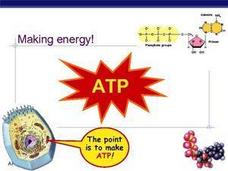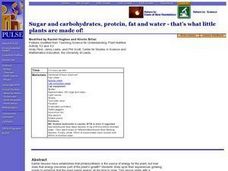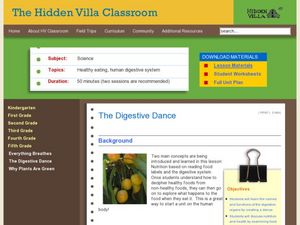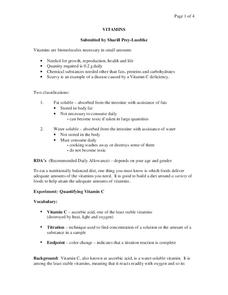Curated OER
Energy Balance: The Ins and Outs
Learners review data from a 24-hour dietary recall to gain a practical understanding of information regarding energy intake and macronutrients.
Curated OER
The Point is to Make ATP
Storing and transferring energy is explained here with reference to the fight or flight response, along with the need for activity in times of lowered nutrition. This is a great summary of ATP applications, and after the multiple stages...
Curated OER
Fueling Body Activities - Digestion
Not only is the human digestive system covered in this biology instructional activity, learners will also explore the digestive process of other animals. The 30 short-answer questions address modes of heterotrophic nutrition, the...
Curated OER
What Nutrients Does My Body Need?
Fourth graders examine roles carbohydrates, protein, fat, and water play in maintaining healthy body, and discuss how food provides fuel (energy) to body, how much fuel body needs, how fuel is used, and what happens to unused fuel.
Curated OER
Determination of the Physical Properties of Dietary Fibers
In this dietary fibers worksheet, students compare and contrast the properties of different fibers: cellulose, hemicellulose, pectin, guar, agar, and xanthan gum. This worksheet has 5 short answer questions.
Curated OER
Training Table Race
Students investigate the role of the carbohydrates food group in sports performance. The difference between simple and complex carbohydrates, and the performance of cardiovascular activities form the focus of the lesson.
Curated OER
Eating Our Way to a Healthy Body: Classifying Foods
Students examine the major food groups. In this classifying foods lesson, students discover the 5 food groups as they read books and play games. Students then sort foods into the appropriate food groups
Curated OER
Sugar and carbohydrates, protein, fat and water - that's what little plants are made of!
Students identify photosynthesis as the mechanism by which plants convert sunlight energy into a usable energy source for plant processes. They identify photosynthesis as the mechanism by which plants create a molecule that can be used...
University of Georgia
The Power of Peanuts
Measure the amount of energy in a peanut by igniting a chemical reaction. Classes use a laboratory setup to burn a peanut and measure the amount of heat it releases through a temperature analysis. They calculate the number of Joules of...
Curated OER
Food for thought
Cake has to be good for something, right? Different foods are used by our bodies in different ways. Learners will first read about what fats, proteins, fruits, and vegetables do for the human body. They will then put each of food shown...
Curated OER
A Funky Healthy Life Style!
Students name the five food groups and classify foods according to group. They tell how proteins, carbohydrates, vitamins/minerals, and water help their body. Students discuss how play and exercise can help their body.
Curated OER
Mission Meals
Students engage in a investigation of the types of meals that astronauts eat in space while examining the types of nutritional elements needed for optimum physical tasks in space. They are given different foods and then document the...
Curated OER
"Mush Lab"
Students use the information they learned from reading food labels to create mush meals. They blend unlikely meals together to form the mush and then evaluate its nutritional value. They examine their own eating habits after the lab is...
Curated OER
Food and the Digestive System
Students investigate the digestive system. In this human biology lesson, students read an article about the digestive system and go onto a suggested website to review what they have learned. Students are asked questions as an assessment.
Curated OER
The Human Organism
Students identify their feelings and learn constructive ways of handling conflict. In this human mental health lesson plan, students identify their feelings, learn how to tell others about their feelings, and learn how to resolve...
Curated OER
Measuring Calories in Food
Students measure the amount of calories in food. In this food energy lesson, students discuss what a calorie is, how our bodies use a calorie, and how many we need. Then, students use a calorimeter to calculate the amount of energy in a...
Curated OER
The Digestive Dance
Students read food labels to compare healthy verses non healthy food and then use diagrams to create a poster of the digestive system. In this food lesson plan, students move the food down the digestive track along the digestive system.
Curated OER
Where's the Beef - Beef Facts or Hype, Is it Bad for You?
Analyze a Happy Meal™ for nutrient content and calories. Blend the contents into "McMush" and use Biuret's solution to test for protein content. There are a few problems with the lesson plan: the resource links are no longer valid, the...
Curated OER
Seed Sensations!
First graders examine seeds. For this Science lesson, 1st graders classify and dissect seeds. Students sprout their own seeds in the classroom.
Curated OER
Chapter 16, Food Biotechnology
Although the points given on these slides are valid, the visual accessibility is poor. Consequently, many viewers would be distracted or entirely unable to view the presentation. The content is a review of microorganisms and their...
Curated OER
Trophic Ecology of Humans
students analyze the place of humans among the tropic levels by observing what we eat. They calculate the caloric content of several foods commonly eaten by humans and calculate the total energy cost to grow, process, transport, store...
Curated OER
Trophic Ecology of Humans
Students analyze the trophic level of humans by first calculating the kilocalories in own their lunch. They then calulate the kilocalories in a wide variety of foods found in grocery stores and compare the kilocalories needed to acquire...
Curated OER
Basic Vitamins: Water-Soluble and Fat-Soluble
Young scholars examine vitamins and study their functions and food sources. They research what happens to vitamins when foods are overcooked. They prepare a microwaveable vegetable quiche.
Curated OER
Vitamins
Young scholars determine the amount of vitamin C present in 3 samples of juice stored in various light conditions. In this vitamin lesson plan, students investigate the amount of vitamin C present in juice exposed to different quantities...

























